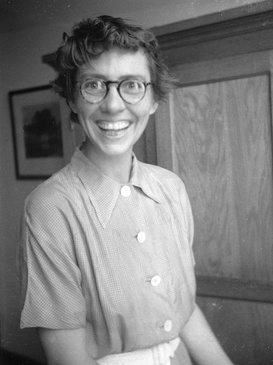Katharine Way facts for kids
Quick facts for kids
Katharine Way
|
|
|---|---|
 |
|
| Born | February 20, 1902 |
| Died | December 9, 1995 (aged 93) |
| Citizenship | United States of America |
| Alma mater | Columbia University University of North Carolina at Chapel Hill |
| Known for | Nuclear Data Project |
| Scientific career | |
| Fields | Physics |
| Institutions | University of Tennessee Manhattan Project National Bureau of Standards Oak Ridge National Laboratory Duke University |
| Thesis | Photoelectric Cross Section of the Deuteron (1938) |
| Doctoral advisor | John Wheeler |
Katharine "Kay" Way (born February 20, 1902 – died December 9, 1995) was an American physicist. She is famous for her work on the Nuclear Data Project. During World War II, she helped with the Manhattan Project. This was a secret project to build the first atomic bomb. She worked at the Metallurgical Laboratory in Chicago. Later, she became a professor at Duke University in 1968.
Contents
Early Life and Education
Katharine Way was born in Sewickley, Pennsylvania. She was the second child of William Addisson Way, a lawyer. Her mother, Louise Jones, died when Kay was twelve. Her father then married a doctor. This stepmother became a great role model for Kay. She showed Kay that women could have successful careers.
Kay went to boarding schools like Miss Hartridge's and Rosemary Hall. In 1920, she started at Vassar College. However, she had to leave after two years because she got sick. Doctors thought she had tuberculosis. After getting better, she studied at Barnard College for a year.
From 1929 to 1934, she studied at Columbia University. There, she became very interested in mathematics. She even wrote her first published paper with a professor. She earned her Bachelor of Science degree in 1932.
Discovering Nuclear Physics
Next, Kay went to the University of North Carolina at Chapel Hill. Here, John Archibald Wheeler, a famous physicist, sparked her interest in nuclear physics. She became his first PhD student. It was hard to find jobs during the Great Depression. So, she stayed on as a student after finishing her PhD requirements.
In 1938, she became a research fellow at Bryn Mawr College. This allowed her to officially receive her PhD. Her thesis was about nuclear physics. It was titled "Photoelectric Cross Section of the Deuteron." After this, she started teaching at the University of Tennessee in 1939. She became an assistant professor in 1941.
At a conference in 1938, Way talked about "Nuclear Quadrupole and Magnetic Moments." She looked at how a spinning atomic nucleus changes shape. She used different models, including Niels Bohr's "liquid drop model." She later studied the liquid drop model more closely. She showed that a nucleus shaped like a cigar could be unstable.
Her professor, John Wheeler, later remembered her work. He said her equations showed a type of instability. This instability was later understood as nuclear fission. Nuclear fission is when an atom's nucleus splits apart.
Working on the Manhattan Project
In 1942, John Wheeler asked Kay Way to join the Manhattan Project. This was a top-secret project during World War II. Its goal was to build the first atomic bomb. Kay worked at the Metallurgical Laboratory in Chicago.
Reactor Calculations
Working with physicist Alvin Weinberg, Kay studied data from Enrico Fermi's early nuclear reactor designs. They wanted to know if a self-sustaining nuclear chain reaction was possible. This is a process where atoms keep splitting, releasing energy. Their calculations were very important for building the Chicago Pile-1. This was the world's first artificial nuclear reactor.
After that, she looked into a problem called "nuclear poisoning." This happens when certain materials created during fission slow down a reactor. With physicist Eugene Wigner, she created the Way-Wigner approximation. This helped predict how fission products decay.
Kay also visited other important sites. These included the Hanford Site and the Los Alamos Laboratory. In mid-1945, she moved to Oak Ridge, Tennessee. There, she continued her research on nuclear decay. She started to focus on collecting and organizing nuclear data.
Sharing Knowledge
In 1946, Kay Way co-edited a book called One World or None: a Report to the Public on the Full Meaning of the Atomic Bomb. She worked with Dexter Masters on this book. It became a bestseller for The New York Times. The book included essays by famous scientists like Niels Bohr and Albert Einstein. It sold over 100,000 copies.
Later Career and Legacy
In 1949, Kay Way moved to Washington, D.C.. She started working for the National Bureau of Standards. Four years later, she convinced the National Academy of Sciences to create the Nuclear Data Project (NDP).
Leading the Nuclear Data Project
The NDP was an organization that collected and shared nuclear data. Kay Way became its leader. In 1964, the NDP moved to the Oak Ridge National Laboratory. Kay remained its head until 1968.
Starting in 1964, the NDP published a journal called Nuclear Data Sheets. This journal shared all the information the NDP had gathered. The next year, a second journal, Atomic Data and Nuclear Data Tables, was added. Kay also convinced the editors of Nuclear Physics to add keywords to their articles. This made it easier to find related information.
Retirement and Advocacy
Kay Way left the NDP in 1968. She became an adjunct professor at Duke University in Durham, North Carolina. She continued to edit Nuclear Data Sheets until 1973. She also edited Atomic Data and Nuclear Data Tables until 1982.
In her later years, she became interested in health issues for older people. She worked to improve health care for seniors. Kay Way never married. She passed away in Chapel Hill, North Carolina, on December 9, 1995.
Images for kids
See also
 In Spanish: Katharine Way para niños
In Spanish: Katharine Way para niños


